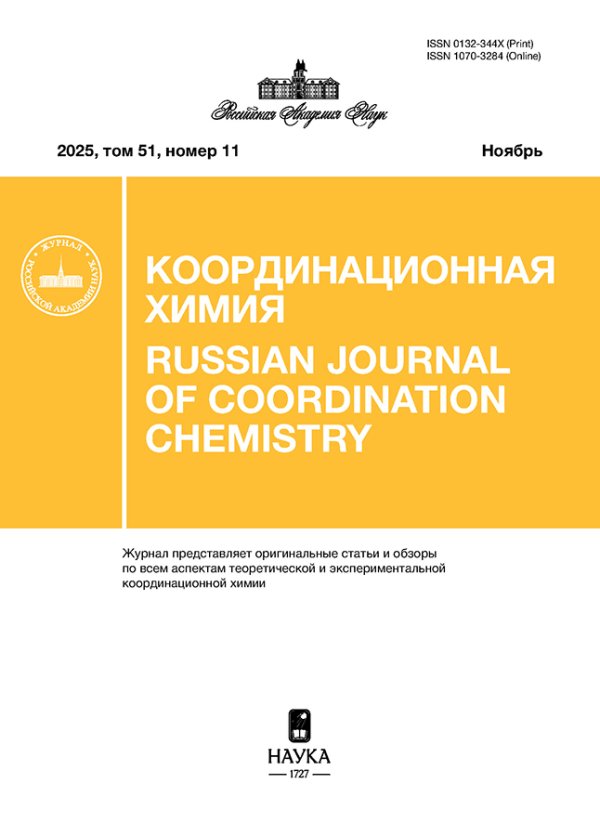Vol 50, No 4 (2024)
Articles
Cadmium(II) Complexes with Redox-Active Indophenol Ligands: Synthesis and Structures
Abstract
The Сd(II) complexes with redox amphoteric 2,6-di-(tret-butyl)-4-((2-hydroxyphenyl) imino)cyclohexa-2,5-dienone ligands L1 and L2 (adducts I, II, and III) are synthesized. The structures of coordinated complexes I, II, and III are determined by X-ray diffraction (XRD) (CIF files CCDC nos. 1838319 (II) and 1838310 (III)) and confirmed by the 1Н, 13С, and 113Cd NMR spectroscopy (for complexes I and III) and IR spectroscopy data.
 223-230
223-230


Effect of Substituents in the Pentafluorobenzoate and 2,3,4,5- and 2,3,5,6-Tetrafluorobenzoate Anions on the Structure of Cadmium Complexes
Abstract
New cadmium 2,3,4,5-tetrafluorobenzoate (6HTfb) and 2,3,5,6-tetrafluorobenzoate (4Htfb) complexes, [Cd(6HTfb)(H2O)3]n·(6HTfb)·2nH2O (I), [Cd3(Phen)2(6HTfb)6] (II, Phen = 1,10-phenanthroline), [Cd2(Phen)2(4Htfb)4]n·2nH2O (III), and [Cd(Phen)2(4Htfb)2] (IV), were synthesized. Analysis of the obtained results and published data demonstrated that a decrease in the number of fluorine substituents is unfavorable for the formation of coordination polymers comprising stacked alternating fluorinated and nonfluorinated aromatic moieties. In the case of 2,4,5-trifluorobenzoate complex, a typical trivial structure of the binuclear cadmium complex with ligand-shielded metal core is formed. The synthesis of 2,3,4,5- and 2,3,5,6-tetrafluorobenzoate complexes produced an intermediate situation and demonstrated that the structure of complex formation products is affected by not only the number, but also the positions of fluorine substituents. Using quantum chemical calculations, it was shown that the formation of coordination polymers requires a molecular precursor with a Chinese lantern structure stable in solutions, while the formation of unusual flattened binuclear complexes with additionally coordinated water molecules requires doubly bridged binuclear complexes able to switch to a conformation with exposed coordinatively unsaturated metal centers.
 231-250
231-250


Influence of the Eliminated Ligand Structure on the Reduction Rate of the Cobalt(III) Complexes
Abstract
The reduction of the heteroleptic cobalt(III) complexes with bipyridine ligands of different structures of the model drug molecule is studied by in situ NMR spectroscopy. The nature of the ligand eliminated during reduction is shown to exert a substantial effect on the reduction rate, which indicates that an optimum amount of cobalt should be chosen for the redox-activated delivery of a certain drug.
 251-260
251-260


Diamidophosphine as a Precursor of the Iminophosphonamidinate Ligand in the Yttrium Complex
Abstract
Diamidophosphine tBuP(NHMes)2(H2L) is synthesized by the treatment of tBuPCl2 with two equivalents of KNHMes (Mes = 2,4,6-Me3C6H2). The reaction of H2L with potassium hydride in THF (THF is tetrahydrofuran) affords the anionic form HL− with the hydrogen atom migrating from nitrogen to phosphorus, which is confirmed by the 1H and 31P NMR data. The structure of the formed iminophosphonamidinate anion HL− is determined by X-ray diffraction (XRD) in the crystalline phase of K[K(THF)2](tBuPH(NMes)2)2 · C7H8 (KHL). The reaction of KHL with yttrium chloride gives complex [Y(tBuPH(NMes)2)2Cl] ([Y(HL)2Cl]) in which, according to the XRD data, ligands HL− are in the iminophosphonamidinate PH form. The 1H and 31P NMR spectra confirm that this structure of the complex exists in the solution.
 261-269
261-269


Dimolybdenum Perfluorotetrabenzoate and Silver Perfluorocyclohexanoate: Synthesis, Evaporation, and Thermodynamic Characteristics
Abstract
Anhydrous dimolybdenum perfluorotetrabenzoate Мо2(ООСС6F5)4 (I) and silver perfluorocyclohexanoate AgOOCC6F11 (II) are synthesized for the first time. Complex I is synthesized by the transcarboxylation of dimolybdenum tetraacetate with pentafluorobenzoic acid. Compound II is synthesized from freshly prepared silver oxide and perfluorocyclohexanoic acid. The evaporation of the complexes is studied by the Knudsen method with mass spectral analysis of the gas phase. The sublimation of Мо2(ООСС6F5)4 is congruent. The enthalpy of sublimation and the equation of the temperature dependence of the vapor pressure are found. The evaporation of AgOOCC6F11 is accompanied by the complete thermal decomposition with the formation of Ag(s) and mainly С6F12, С6F10, and CO2 molecules. The standard enthalpies of thermal decomposition (∆rH°298.15(5) = 439.5 Ѓ} 16.4 kJ/mol, (∆rH°298.15(6) = 325.2 Ѓ} 14.0 kJ/mol) and formation of the silver complex ((∆rH°298.15(AgOOCC6F11, c) = –2751.0 Ѓ} 24.4 kJ/mol) are determined.
 270-277
270-277


Alkyltriphenylphosphonium Arenesulfonates: Synthesis and Structures
Abstract
The reactions of equimolar amounts of alkyltriphenylphosphonium bromide with arenesulfonic acids in an aqueous-acetone solution afford alkyltriphenylphosphonium arenesulfonates [Ph3PCH2ОMe][OSO2C6H3(OH-4)(COOH-3)] (I), [Ph3PCH2СN][OSO2C6H4(COOH)-2] (II), [Ph3PCH2C(O)Me][OSO2С6H4(COOH-2] (III), and [Ph3PCH2C(O)Me][OSO2Naft-1] (IV). According to the X-ray diffraction (XRD) data, the crystals of compounds I−IV have ionic structures with tetrahedral alkyltriphenylphosphonium cations (P−С 1.7820(19)−1.8330(20) A, CPC 05.37(10)°−112.09(12)°) and arenesulfonate anions. The crystal of compound I contains hydrogen bonds (S=O∙∙∙H−OC(O) 1.87 A) linking the arenesulfonate anions into chains. The structural organization of the crystals of compounds I−IV is mainly formed due to numerous weak hydrogen bonds between the cations and anions, for instance, S=O∙∙∙H−Car (2.29−2.70 A), C=O∙∙∙H–C (2.48 and 2.59 A), and N∙∙∙H–C (2.62−2.68 A).
 278-284
278-284












